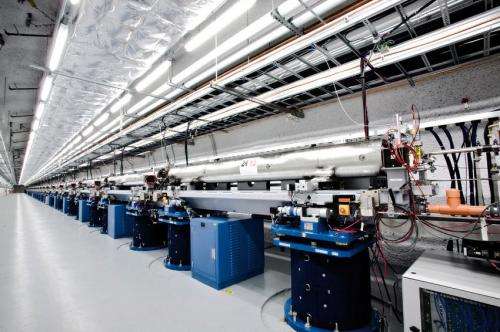Ultra-short X-ray pulses explore the nano world

Ultra-short and extremely strong X-ray flashes, as produced by free-electron lasers, are opening the door to a hitherto unknown world. Scientists are using these flashes to take "snapshots" of the geometry of tiniest structures, for example the arrangement of atoms in molecules. To improve not only spatial but also temporal resolution further requires knowledge about the precise duration and intensity of the X-ray flashes. An international team of scientists has now tackled this challenge.
X-ray flashes are a unique scientific tool. They are generated by accelerating electrons to very high energy levels in kilometer-long vacuum tubes, so-called linear accelerators, and then deflecting them with specially arranged magnets. In the process the particles emit X-ray radiation that is amplified until an ultra-short and intensive X-ray flash is released.
Researchers use these X-ray flashes to resolve structures as small as one ten billionth of a meter (0.1 nanometer) in size. That is roughly the diameter of a hydrogen atom. In this way, biomolecules, for example, can be imaged at extremely high resolution, providing new insight into the nano cosmos of nature.
Using two quickly sequenced flashes the researchers can even obtain information on structural changes during reactions. The first laser flash triggers a reaction while the second measures structural changes during the reaction. For this it is essential to know the precise duration and temporal intensity distribution of the X-ray flashes. However, hitherto it has not been possible to measure the ultra-short pulses directly.
Researchers at the Technische Universität München (TUM), the Hamburg Center for Free-Electron Laser Science (CFEL) and the Max Planck Institute of Quantum Optics (MPQ) in Garching, in collaboration with other colleagues, have now developed just such a methodology. The respective experiments were done at the SLAC National Accelerator Laboratory in California (USA) by a team headed by Professor Reinhard Kienberger, Dr. Wolfram Helml (TUM) and Dr. Andreas Maier (CFEL).
The scientists determined the duration of the X-ray flashes by modifying a process originally developed to measure ultra-short flashes of light. The physicists directed the X-ray flashes into a vacuum chamber filled with a few atoms of an inert gas. There they superimposed the flashes with 2.4 micrometer wavelength pulses of infrared light.
When the X-ray flashes hit a gas atom they knock electrons out of the innermost shell, setting them free. After being liberated the electrons are accelerated or decelerated by the electrical field of the infrared light pulse. The change in an electron's velocity is a function of when the light intercepts the electron, and thus of the electrical field strength at the moment of ionization.
Since electrons are set free during the full duration of an X-ray flash, electrons emitted at different points in time "feel" different field strengths of the periodically oscillating infrared light. As a result they are accelerated at varying rates. The physicists can then calculate the duration of the original X-ray flash from the different arrival times of the electrons in a detector.
Using this approach, the researchers determined that the average pulse duration doesn't exceed four and a half femtoseconds – a femtosecond is a millionth of a billionth of a second (10-15 seconds). In addition, the researchers obtained insight into the structure of the X-ray flashes.
A characteristic of the intense X-ray flashes generated in free-electron lasers is their randomly changing pulse form. A typical X-ray pulse comprises multiple contiguous shorter "X-ray spikes." The number and intensity of these spikes varies from one shot to the next.
For the first time ever, the researchers managed to measure these ultra-short sub-peaks directly and confirm predictions that the individual flashes last only around 800 attoseconds – an attosecond is a billionth of a billionth of a second (10-18 seconds). The new methodology allows the detailed, direct temporal measurement of X-ray pulses and augments methodologies for determining pulse shape and length indirectly from the structure of the electron packets used to generate the flashes.
The enhanced X-ray pulse measurement technology may also find application at the new Center for Advanced Laser Applications (CALA) at the Garching campus. Researchers there are working on, among other things, generating even shorter X-ray pulses using high-energy lasers. Pulses with a duration of only a few attoseconds, would allow researchers to take "snapshots" of even faster processes in nature, like the movement of electrons around atomic nuclei.
However, X-ray flashes provide not only basic research with new perspectives. Medicine could also profit from the technology. "Ultra-short laser-like X-ray pluses serve not only the investigation of the fastest physical processes at the core of matter, but could, because of their extremely high intensity, also be used to destroy tumors following X-ray diagnosis," explains Reinhard Kienberger, professor for laser and X-ray physics at TU München and leader of the research consortium.
More information: W. Helml, A. R. Maier, W. Schweinberger, I. Grguraš, P. Radcliffe, G. Doumy, C. Roedig, J. Gagnon, M. Messerschmidt, S. Schorb, C. Bostedt, F. Grüner, L. F. DiMauro, D. Cubaynes, J. D. Bozek, Th. Tschentscher, J. T. Costello, M. Meyer, R. Coffee, S. Düsterer, A. L. Cavalieri & R. Kienberger, Measuring the temporal structure of few-femtosecond FEL X-ray pulses directly in the time domain, Nature Photonics online, 24. November 2014, DOI: 10.1038/NPHOTON.2014.278
Journal information: Nature Photonics
Provided by Technical University Munich





















